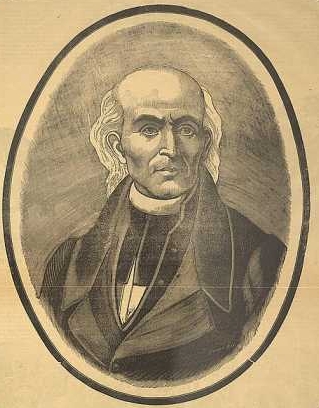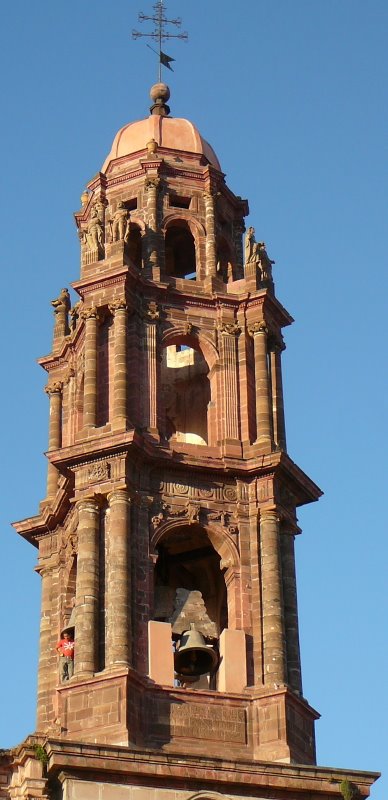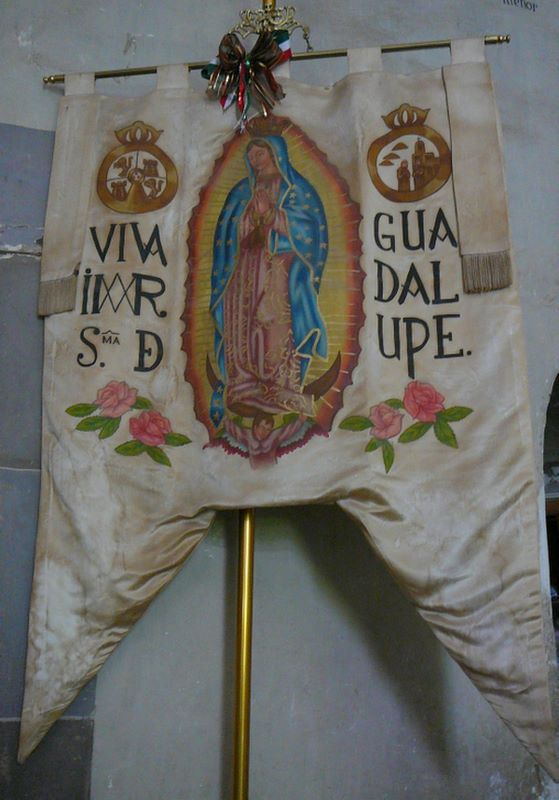Like its upscale neighbor, San Miguel de Allende just
down the Río De La Laja, Dolores Hidalgo added a revolutionary surname
to the Christian name given by the Spanish viceroys. Before 1570,
the hamlet was an Otomi settlement called Cocomacan. Arriving a millennium before the Spanish, the Otomi were never subdued by the Aztecs
who would occasionally use them as mercenaries. But when hired to
fight the Spaniards, the Otomi turned the tables and worked for the
latest conqueror. Spaniards would often move Otomi into these central
Mexican parts to provide agricultural labor for the haciendas when the
Spanish were unable to "tame" the local fierce Chichimecas. 
In 1570, Spanish Viceroy Enriquez de Almanza established the Congregation of Nuestra Señora Dolores (Our Lady of Sorrows) -- but no church was built until 140 years later when the village grew to support the nearby Hacienda de la Erre, a large cattle ranch established by the viceroy.
After the last Spanish viceroy officially recognized Mexican independence through the 1821 Treaty of Córdoba, the town took as its last name that of its most famous citizen, the priest Miguel Hidalgo y Costilla (see drawing at right). Currently this town of about 50,000 has added a moniker as "cradle of independence" and now sports the jawbreaker name of Dolores Hidalgo Cuna de la Independencia Nacional. Nowhere near as attractive to the expat crowd as nearby San Miguel de Allende, the center of the town has an authentic Mexican feel to it throughout. Somehow it prepares for the upcoming bicentenary (1810) of the War of Independence without Starbucks and Wifi in the central park.
Erected on the anniversary of the Cry of Delores in 1891: Sculptor Miguel Noreña bronze of Miguel Hidalgo
Hildago was always a bit of a rebel and many of his fellow priests considered him a heretic. A great friend of the Indian population, he learned Aztec and several indigenous languages.The main square (called the Plaza Principal) is lively and well landscaped with the same French garden feel of other squares remodeled around the turn of the 20th century when dictator and Francophile Porfirio Díaz ordered their redesign.
The arcaded building above is now a museum; it was built in the 18th century as a prison. Father Hidalgo emptied it at the start of the revolution so its occupants could share in his fun.
The Mexican sun flowers Bougainvilleas in this immaculately maintained garden 6200 feet above sea level.
The Plaza Principal supposedly has a tree grown from a sapling of the Noche Triste--the tree where Hernán Cortés wept after the Aztecs nearly wiped him out in 1521 as he tried to escape their Capital at Tenochtitlan (now part of Mexico city). The Aztecs had picked Tenochtitlan after following an Eagle carrying a snake (just like those bronzed at the foot of Father Hidalgo's statue nearby). We could not locate Cortés's tree but thought we'd include a gratuitous bougainvillea shot in its place.
Pictured below is ground zero of the war of independence from Spain. From these steps of the Parroquia (parish church), late on the night of September 15, 1810, Father Miguel Hidalgo issued his famous Grito de Dolores-- the call to insurrection for the indigenous population. Or maybe not: what Hidalgo really said was not written down; mythmakers have created several versions and the Mexican president reenacts this event annually after Delores Hidalgo's church bell, since moved to the National Palace in Mexico City, is rung. This bell summoned the natives to their ill-organized rebellion on September 16. The rest, as they cliche, is history.
Although built over 65 years, this church is consistent and symmetric in its baroque Churrigueresque ornamentation. While the artistic roots of the Churrigueresque are somewhat in dispute (what part of Spain did it come from, exactly?) we know it when we see it. And we see it here: Those six impossibly tall and impossibly ornamented columns (called estipites) rising from the church door to the central Crucifix. These passionately suggest influence that made the Mexico of its day including the Moorish Mudéjar filtered through Spain. The central window is anything-but-rectangular with ornamentation wrapping around it and a relief sculpture above. On both sides of the highly decorated facade rise completely plain edges -- forming a picture frame to heighten the "surprise" that is characteristic of the baroque, which tolerates many variations including the Churrigueresque. (Click on any of these pictures to study enlargements). |
|
| Left: The Churrigueresque style of Dolores Hidalgo's Parroquia tower was out of vogue when... | The Neoclassic tower at San Miguel de Allende's San Francisco Church. This church had started construction in the Churrigueresque style. Click here to see more of this church. |
This is of the obscure St. Nicodemus. Note the leaf ornamentation. While commonly thought of as architecture, Churrigueresque is really a lavish style of ornamentation.
The interior of the church (below) is Mexican baroque. Our late afternoon arrival found a lively service in progress so we were unable to get many pictures.
The main altar with its Corinthian columns looks neoclassic. However, the wall of the right transept contains one of the regions most significant retables (the ceiling-high altar backgrounds). Unlike most retables in this land of silver and gold, it is not gilded. Father Hidalgo's town was, after all, quite poor. It's hard to start a social revolution among the rich.
Want to explore more of this region? If so, see our overview page of the neighboring San Miguel de Allende by clicking here.
Geek and Legal StuffPlease allow JavaScript to enable word definitions. This page has been tested in Internet Explorer 7.0 and Firefox 2.0. Created April 2008 |
 |
Overview of San Miguel
Churches of San Miguel
Oases of Green
Culture
 To see the Banner of Guadalupe and other scenes from the Shrine of Atotonilco, click here.
To see the Banner of Guadalupe and other scenes from the Shrine of Atotonilco, click here.